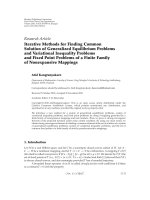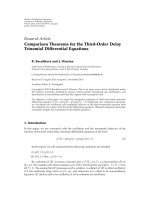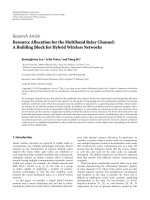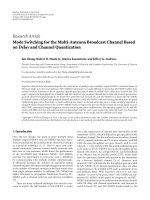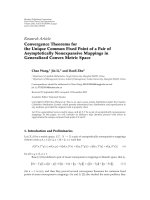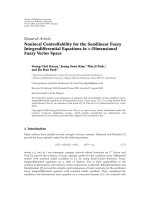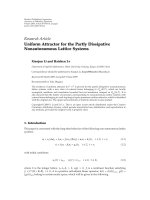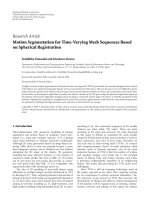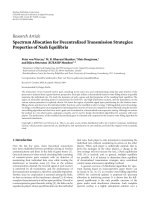Báo cáo hóa học: "Research Article Harnack Inequality for the Schrödinger Problem Relative to Strongly Local Riemannian p-Homogeneous Forms with a Potential in the Kato Class" potx
Bạn đang xem bản rút gọn của tài liệu. Xem và tải ngay bản đầy đủ của tài liệu tại đây (599.07 KB, 19 trang )
Hindawi Publishing Corporation
Boundary Value Problems
Volume 2007, Article ID 24806, 19 pages
doi:10.1155/2007/24806
Research Article
Harnack Inequality for the Schrödinger Problem Relative
to Strongly Local Riemannian p-Homogeneous Forms with
a Potential in the Kato Class
Marco Biroli and Silvana Marchi
Received 17 May 2006; Revised 14 September 2006; Accepted 21 September 2006
Recommended by Ugo Gianazza
We define a notion of Kato class of measures relative to a Riemannian strongly local p-
homogeneous Dirichlet form and we prove a Harnack inequality (on balls that are small
enough) for the positive solutions to a Schr
¨
odinger-type problem relative to the form
with a potential in the Kato class.
Copyright © 2007 M. Biroli and S. Marchi. This is an open access article distributed un-
der the Creative Commons Attribution License, which permits unrestricted use, distri-
bution, and reproduction in any medium, provided the original work is properly cited.
1. Introduction
In this paper we are interested in a Harnack inequality for the Schr
¨
odinger problem rel-
ative to strongly local Riemannian p-homogeneous forms with a potential in the Kato
class.
The first result in the case of Laplacian has been given by Aizenman and Simon [1].
They proved a Harnack inequality for the corresponding Schr
¨
odinger problem with a
potential in the Kato measures, by probabilistic methods.
In 1986, Chiarenza et al. [2] gave an analitical proof of the result in the case of elliptic
operators with bounded measurable coefficients.
Citti et al. [3] investigated the case of the subelliptic Laplacian and in 1999 Biroli and
Mosco [4, 5] extended the result to the case of Riemannian strongly local Dirichlet forms
(we recall also that in [6] a Harnack inequality for positive harmonic functions relative to
a bilinear strongly local Dirichlet form is proved).
Biroli [7] considered the case p>1forthesubellipticp-Laplacian, and defining a suit-
able Kato class for this case, he obtained again Harnack and H
¨
older inequalities, by meth-
ods that use uniform monotonicity properties and a proof by contradiction. The proofs
are not easy to be generalized to the case of strongly local Riemannian p-homogeneuous
2 Boundary Value Problems
forms essentially due to the absence of any monotonicity property and the absence of a
notion of translation or dilation.
In this paper we consider the case of strongly local Riemannian p-homogeneous forms;
we define a suitable notion of Kato class of measures. We assume that the potential is a
measure in the Kato class and we prove a Harnack inequality (on balls that are small
enough for the intrinsic distance). The main difference with respect to [7]istheproof
of the L
∞
-local estimate. Here it is based on methods from [8, 9] instead of a variant of
Moser iteration technique. Finally we will point out that methods of the same type have
been also used in [10] in the framework of strongly local Riemannian p-homogeneuous
forms. We conclude this introduction remarking our hope to prove similar results also in
the parabolic case.
1.1. Assumptions and preliminary results. Firstly we describe the notion of strongly
local p-homogeneous Dirichlet form, p>1, as given in [11].
We consider a locally compact separable Hausdorff space X with a metrizable topol-
ogy and a positive Radon measure m on X such that supp[m]
= X.LetΦ : L
p
(X,m) →
[0,+∞], p>1, be a l.s.c. strictly convex functional with domain D, that is, D ={v : Φ(v) <
+
∞},suchthatΦ(0) = 0. We assume that D is dense in L
p
(X,m) and that the following
conditions hold.
Assumption (H
1
). D is a dense linear subspace of L
p
(X,m), which can be endowed with a
norm
·
D
;moreoverD has a structure of Banach space with respect to the norm ·
D
and the following estimate holds:
c
1
v
p
D
≤ Φ
1
(v) = Φ(v)+
X
|v|
p
dm ≤ c
2
v
p
D
(1.1)
for every v
∈ D,wherec
1
and c
2
are positive constants.
Assumption (H
2
). We denote by D
0
the closure of D ∩ C
0
(X)inD (with respect to the
norm
·
D
) and we assume that D ∩ C
0
(X)isdenseinC
0
(X) for the uniform conver-
gence on X.
Assumption (H
3
). For every u,v ∈ D ∩ C
0
(X), we have u ∨ v ∈ D ∩ C
0
(X), u ∧ v ∈ D ∩
C
0
(X)and
Φ(u
∨ v)+Φ(u ∧ v) ≤ Φ(u)+Φ(v). (1.2)
Assumptions (H
1
), (H
2
), and (H
3
) allow us to define a capacity relative to the func-
tional Φ (and to the measure space (X,m)). The capacity of an open set O is defined
as
cap
Φ
(O) = inf
Φ
1
(v); v ∈ D
0
, v ≥ 1a.e.onO
(1.3)
if the set
{v ∈ D
0
, v ≥ 1a.e.onO} is not empty, and
cap
Φ
(O) = +∞ (1.4)
M. Biroli and S. Marchi 3
if the set
{v ∈ D
0
, v ≥ 1a.e.onO} is empty. Let E be a subset of X;wedefine
cap
Φ
(E) = inf
cap(O); O open set with E ⊂ O
. (1.5)
We recall that the above-defined capacity is a Choquet capacit y [12]. Moreover we can
prove that every function in D
0
is quasi-continuous and is defined quasi-everywhere (i.e.,
a function in u
∈ D
0
is a.e. equal to a function u, such that for all > 0 there exists a set
E
with cap(E
) ≤
and u continuous on X − E
)[12].
Assumptions (H
1
), (H
2
), and (H
3
)haveaglobal character and are generalizations of
the condition defining a bilinear regular Dirichlet form [13]. For bilinear Dirichlet forms
the existence of a measure energy density depends only on a locality assumption; in the
nonlinear case this does not hold in general and the existence and some easy properties
of the measure energy density has to be assumed. We recall now the definition of strongly
local Dir ichlet functional with a homogeneity degree p>1. Let Φ satisfy (H
1
), (H
2
), and
(H
3
); we say that Φ is a strongly local Dirichlet functional with a homogeneity degree p>1
if the following conditions hold.
Assumption (H
4
). Φ has the following representation on D
0
: Φ(u) =
X
α(u)(dx), where
α is a nonnegative bounded Radon measure depending on u
∈ D
0
, which does not charge
sets of zero capacity. We say that α(u) is the energy (measure) of our functional. The
energy α(u) (of our functional) is convex with respect to u in D
0
in the space of measures,
that is, if u,v
∈ D
0
and t ∈ [0,1] then α(tu +(1− t)v) ≤ tα(u)+(1− t)α(v), and it is
homogeneous of degree p>1, that is, α(tu)
=|t|
p
α(u), for all u ∈ D
0
,forallt ∈ R.
Moreover the following closure property holds: if u
n
→ u in D
0
and α(u
n
)convergesto
χ in the space of measures, then χ
≥ α(u).
Assumption (H
5
). α is of strongly local type, that is, if u,v ∈ D
0
and u − v = constant on
an open set A,wehaveα(u)
= α(v)onA.
Assumption (H
6
). α(u)isofMarkovtype;ifβ ∈ C
1
(R)issuchthatβ
(t) ≤ 1andβ(0) = 0
and u
∈ D ∩ C
0
(X), then β(u) ∈ D ∩ C
0
(X)andα(β(u)) ≤ α(u) in the space of measures.
Let Φ(u)
=
X
α(u)(dx) be a strongly local Dirichlet functional with domain D
0
.As-
sume that for every u,v
∈ D
0
we have
lim
t→0
α(u + tv) − α(u)
t
= μ(u,v) (1.6)
in the weak
topology of ᏹ (where ᏹ is the space of Radon measures on X) uniformly for
u, v in a compact set of D
0
,whereμ(u,v)isdefinedonD
0
× D
0
and is linear in v.Wesay
that Ψ(u,v)
=
X
μ(u,v)(dx)isastrongly local p-homogeneous Dirichlet form.Weobserve
that (H
3
)isaconsequenceof(H
1
), (H
2
), and (H
4
)–(H
6
). The strong locality property al-
lows us to define the domain of the form with respect to an open set O, denoted by D
0
[O]
and the local domain of the form with respect to an open set O, denoted by D
loc
[O]. We
recall that, given an open set O in X, we can define a Choquet capacity cap(E;O)foraset
E
⊂ E ⊂ O with respect to the open set O. Moreover the sets of zero capacity are the same
with respect to O and to X.
4 Boundary Value Problems
Werecallnowsomepropertiesofstronglylocal(p-homogeneous) Dirichlet forms,
which will be used in the following (for the proofs we refer to [11, 12]).
Lemma 1.1. Let Ψ(u,v)
=
X
μ(u,v)(dx) be a strongly local p-homogeneous Dirichlet form.
Then the following properties hold.
(a) μ(u,v) is homogeneous of degree p
− 1 in u and linear in v, one has also μ(u,u) =
pα(u).
(b) Chain rule: if u,v
∈ D
0
and g ∈ C
1
(R) with g(0) = 0 and g
bounded on R, then
g(u) and g(v) belong to D
0
and
μ
g(u),v
=
g
(u)
p−2
g
(u)μ(u,v),
μ
u,g(v)
=
g
(v)μ(u,v).
(1.7)
Obser ve that one has a lso, a chain rule for α,
α
g(u)
=
g
(u)
p
α(u). (1.8)
(c) Truncation property: for every u,v
∈ D
0
,
μ
u
+
,v
=
1
{u>0}
μ(u,v),
μ
u,v
+
=
1
{v>0}
μ(u,v),
(1.9)
where the above relations make sense, since u and v are defined quasi-everywhere.
(d) for all a
∈ R
+
,
μ(u,v)
≤
α(u + v) ≤ 2
p−1
a
−p
α(u)+2
p−1
a
p(p−1)
α(v). (1.10)
(e) Leibniz rule with respect to the second argument:
μ(u,vw)
= vμ(u,w)+wμ(u,v), (1.11)
where u
∈ D
0
, v,w ∈ D
0
∩ L
∞
(X,m).
(f) For any f
∈ L
p
(X,α(u)) and g ∈ L
p
(X,α(v)) with 1/p+1/p
= 1, fgis integrable
w ith respect to the absolute variation of μ(u,v) and for all a
∈ R
+
,
fg
μ(u,v)
(dx) ≤ 2
p−1
a
−p
f
p
α(u)(dx)+2
p−1
a
p(p−1)
g
p
α(v)(dx). (1.12)
(g) Properties (e) and (f) give a Leibniz inequality for α, that is, there exists a constant
C>0 such that
α(uv)
≤ C
|
u|
p
α(v)+|v|
p
α(u)
(1.13)
for every u,v
∈ D
0
∩ L
∞
(X,m).
The properties (a)–(f) are analogous to the corresponding properties of strongly local
bilinear Dir ichlet forms [6, 13]. Concerning (g) we observe that in the bilinear case the
Leibniz rule holds for both the arguments of the form [ 6, 13], but in the nonlinear case
the property holds only for the second argument.
M. Biroli and S. Marchi 5
We list now the assumptions that give the relations between the topology, the distance
and the measure on X.
Assumption (H
7
). A distance d is defined on X,suchthatα(d) ≤ m in the sense of the
measures.
(i) The metric topology induced by d is equivalent to the original topology of X.
(ii) Denoting by B(x,r)theballofcenterx and radius r (for the distance d), for every
fixed compact set K, there exist positive constants c
0
and r
0
such that
m
B(x,r)
≤
c
0
m
B(x,s)
r
s
ν
∀x ∈ K,0<s<r<r
0
. (1.14)
We assume without loss of generality p
2
< ν.
Remark 1.2. (a) Assume that
d(x, y)
= sup
ϕ(x) − ϕ(y):ϕ ∈ D ∩ C
0
(X), α(ϕ) ≤ m on X
(1.15)
defines a distance on X, which satisfies (i); then d is in D
loc
[X]andα(d) ≤ m;sowecan
use the above-defined d as distance on X.
(b) We observe that from (i) and (ii) X has a st ructure of locally homogeneous space
[14]. Moreover the condition, for every fixed compact set K there exist positive constants
c
1
and r
0
such that
0 <m
B(x,2r)
≤
c
1
m
B(x,r)
∀
x ∈ K,0<r<2r
0
, (1.16)
c
1
< 1, implies (ii) for a suitable ν.
(c) From the properties of d it follows that for any x
∈ X there exists a function φ(·) =
φ(d(x,·)) such that φ ∈ D
0
[B(x,2r)], 0 ≤ φ ≤ 1, φ = 1, on B(x, r)and
α(φ)
≤
2
r
p
m. (1.17)
(d) From the assumptions on X and from (ii) the following property follows. For every
fixed compact set K, such that the neighborhood of K of radius r
0
(for the distance d)is
strictly contained in X, there exists a positive constant c
0
,dependingonc
0
,suchthat
m(B(x,2r)
− B(x, r)) ≥ c
0
m(B(x,2r)) for every x ∈ K and 0 <r<r
0
/2.
The following assumption describes the functional relations between d, m, and the
form.
Assumption (H
8
). We assume also that the following scaled Poincar
´
einequalityholds. For
every fixed compact set K, there exist positive constants c
2
, r
1
,andk ≥ 1suchthatfor
every x
∈ K and every 0 <r<r
1
,
B(x,r)
u − u
x,r
p
m(dx) ≤ c
2
r
p
B(x,kr)
μ(u,u)(dx) (1.18)
for every u
∈ D
loc
[B(x,kr)], where u
x,r
= (1/m(B(x,r)))
B(x,r)
um(dx).
6 Boundary Value Problems
Astronglylocalp-homogeneous Dirichlet form, such that the above assumptions
hold, is called a Riemannian Dirichlet form.
As proved in [15] the Poincar
´
e inequality implies the following Sobolev inequality:for
every fixed compact set K, there exist positive constants c
3
, r
2
,andk ≥ 1suchthatfor
every x
∈ K and every 0 <r<r
2
,
1
m
B(x,r)
B(x,r)
|u|
p
∗
m(dx)
1/p
∗
≤c
3
r
p
m
B(x,r)
B(x,kr)
μ(u,u)(dx)+
r
p
m
B(x,r)
B(x,r)
|u|
p
m(dx)
1/p
(1.19)
with p
∗
= pν/(ν − p)andc
3
, r
2
depending only on c
0
, c
2
, r
0
, r
1
.Weobservethatwecan
assume without loss of generality r
0
= r
1
= r
2
.
Remark 1.3. (a) From (1.18) we can easily deduce by standard methods that
1
m
B(x,r)
B(x,r)
|u|
p
m(dx) ≤ c
2
r
p
m
B(x,r) ∩{u = 0}
B(x,kr)
μ(u,u)(dx), (1.20)
where c
2
is a positive constant depending only on c
2
.
(b) From (a) it follows that for ever y fixed compact set K, such that the neighbor hood
of K of radius r
0
is strictly contained in X,
B(x,r)
|u|
p
m(dx) ≤ c
2
r
p
B(x,kr)
μ(u,u)(dx) (1.21)
for every x
∈ K and 0 <r<r
0
/2, where c
2
depends only on c
2
and c
0
.
As a consequence of Remark 1.2(d) and of the Poincar
´
e inequality, we have the follow-
ing estimate on the capacity of a ball.
Proposition 1.4. For every fixed compact set K, there exist positive constants c
4
and c
5
such
that
c
4
m
B(x,r)
r
p
≤ cap
B(x,r),B(x,2r)
≤
c
5
m
B(x,r)
r
p
, (1.22)
where x
∈ K and 0 < 2r<r
0
.
The definition of Kato class of measure was initially given by Kato [16] in the case of
Laplacian and extended in [2] to the case of elliptic operators with bounded measurable
coefficients.
Kato classes relative to a subelliptic Laplacian were defined in [3], and the case of
(bilinear) Riemannian Dirichlet form was considered in [4, 17].
In [7] the Kato class was defined in the case of subelliptic p-Laplacian and in [10]
the following definition of Kato class relative to a Riemannian p-homogeneous Dirichlet
form has been given.
M. Biroli and S. Marchi 7
Definit ion 1.5. Let σ be a Radon measure. Say that σ is in the Kato space K(X)if
lim
r→0
η
σ
(r) = 0, (1.23)
where
η
σ
(r) = sup
x∈X
r
0
|
σ|
B(x,ρ)
m
B(x,ρ)
ρ
p
1/(p−1)
dρ
ρ
. (1.24)
Let Ω
⊂ X be an open set; K(Ω)isdefinedasthespaceofRadonmeasuresσ on Ω such
that the extension of σ by 0 out of Ω is in K(X).
In [10] we have investigated the properties of the space K(Ω). In particular we have
proved that if Ω is a relatively compact open set of diameter
R/2, then
σ
K(Ω)
:= η
σ
(R)
p−1
(1.25)
is a norm on K(Ω)and,asin[18] for the bilinear case, we can prove that K(Ω)endowed
with this norm is a Banach space. Moreover we have proved that K(Ω) is contained in
D
[Ω], where D
[Ω] denotes the dual of D
0
[Ω].
1.2. Results. We state now the result that we will prove in the following sections. Let
Ω
⊂ X be a relatively compact open set. We denote by c
0
, c
2
, r
0
the constants appearing in
(1.14)and(1.18)relativetothecompactset
Ω. We assume that a neighborhood of Ω of
radius
R/2+r
0
is strictly contained in X (R = 2diamΩ), that
X
μ(u,v)(dx)isaRiemann-
ian (p-homogeneous) Dirichlet form, and that u
∈ D
loc
(Ω)with
Ω
μ(u,u)(dx) < +∞ is a
subsolution of the problem
Ω
μ(u,v)+
Ω
|u|
p−2
uvσ(dx) = 0foreveryv ∈ D
0
(Ω), supp(v) ⊂ Ω, (1.26)
where σ
∈ K(Ω), that is,
Ω
μ(u,v)+
Ω
|u|
p−2
uvσ(dx) ≤ 0 for every positive v ∈ D
0
(Ω), supp(v) ⊂ Ω.
(1.27)
Remark 1.6. We observe that the problems (1.26)and(1.27) make sense, due to a Schech-
ter type inequality, which we will prove in Section 2, giving the continuous embedding of
D
loc
[Ω]intoL
p
loc
(Ω,σ).
OurfirstresultisalocalL
∞
estimate for positive subsolutions of (1.26)
Theorem 1.7. Let x
0
∈ Ω.Foreveryq>0 there exist positive structural constants C
q
(de-
pending on q)andR
0
(depending on σ) such that, for eve ry positive local subsolution u of
(1.26)andeveryr
≤ R
0
, such that B
x
0
,2r
⊂ Ω, one has
sup
B(x
0
,r/2)
u ≤ C
q
1
m
B
x
0
,r
B(x
0
,r)
u
q
m(dx)
1/q
. (1.28)
8 Boundary Value Problems
We prove Theorem 1.7 in Section 1 by methods derived from [10]. We use Theorem
1.7 to prove in Section 2 the following Harnack inequality.
Theorem 1.8. Let x
o
∈ Ω. There exist positive structural constants
C and R
1
(depending on
σ) such that for every positive local solution u of (1.26)andeveryr
≤ R
1
such that B
x
0
,2r
⊂ Ω,
one has
sup
B(x
0
,r)
u ≤
C inf
B(x
0
,r)
u. (1.29)
We can assume without loss of generality R
0
= R
1
.FromTheorem 1.8 we obtain the
following result on the continuity of harmonic functions (local solutions) for (1.26).
Theorem 1.9. Every local solut ion of (1.26)iscontinuousinΩ.Moreoverifσ(B(x,r))
≤
c(x)r
ν−p+
for some > 0 and for a continuous function c(x) (of x ∈ Ω), then u is locally
H
¨
older continuous in Ω.
Each of Theorems 1.8 and 1.9 follow from the for mer. We follow the met hod of [7]to
prove Theorems 1.8 and 1.9. Because of the great gener ality of the st ructure we cannot
apply the Moser iteration technique to prove Theorem 1.7 whichfollowsfromaSchecter-
type inequality and an iterative application of a Cacciopoli-type inequality, introduced in
[9] in the Euclidean case and extended by [19] to the subelliptic framework and in [10]
to our general framework.
2. Proof of Theorem 1.7
Let σ
∈ K(Ω)andB = B(x
0
,r) ⊂⊂ Ω, we denote
η
μ,B
(r) = sup
x∈B
r
0
|
σ|
B(x,ρ)
m
B(x,ρ)
ρ
p
1/(p−1)
dρ
ρ
. (2.1)
Consider the problem
B
μ(w,v)(dx) =
B
vσ(dx), (2.2)
w
∈ D
0
(B), for any v ∈ D
0
(B) with compact support in Ω.
Proposition 2.1. Let w
∈ D
0
(B) be a subsolution of (2.2). The n there exists a structural
constant C depe nding on σ such that
sup
B
|w|≤Cη
σ
(2r). (2.3)
Proof. In this proof we denote by C possibly different structural constants.
We observe that
|w| is a subsolution of problem (2.2). Then from [10, Theorem 1.1]
it follows that
sup
B
|w|≤C
1
m(B)
B
|w|
p
m(dx)
1/p
+ η
σ,B
(2r)
, (2.4)
M. Biroli and S. Marchi 9
where C is independent on r.ByPoincar
´
e inequalit y, (2.4)gives
sup
B
|w|≤C
r
p
m(B)
B
α(w)(dx)
1/p
+ η
σ,B
(2r)
. (2.5)
From (2.2)withv
= w and (2.5), we obtain
B
α(w)(dx) ≤ C
|
σ|(B)
p
r
p
m(B)
1/p
B
α(w)(dx)
1/p
+ C|σ|(B)η
σ,B
(2r) (2.6)
and applying Young inequality to the first term in the right-hand side of (2.6), we have
B
α(w)(dx) ≤ C|σ|(B)η
σ,B
(2r). (2.7)
Combining (2.5)and(2.7)gives
sup
B
|w|≤C
|
σ|(B)
m(B)
r
p
η
σ,B
(2r)
1/p
+ η
σ,B
(2r)
(2.8)
and applying Young inequality,
sup
B
|w|≤C
|
σ|(B)
m(B)
r
p
1/(p−1)
+ η
σ,B
(2r)
≤
Cη
σ,B
(2r). (2.9)
Proposition 2.2 (Schechter’s inequality). Let x
0
∈ Ω and for any ρ>0 denote B
ρ
=
B(x
0
,ρ).
For any 0 <
< 1, there exist some constants t
0
> 0 and C() > 0 such that B
2t
0
⊂⊂Ω and
such that if 0 <s<t
≤ t
0
, then
B
s
|u|
p
|σ|(dx) ≤
B
t
α(u)(dx)+
C(
)
(t − s)
p
B
t
−B
s
|u|
p
m(dx) (2.10)
for every u
∈ D
loc
(B
t
),whereC() depends on and the structural constants. In particular
if u
∈ D
0
(B
t
), then
B
s
|u|
p
|μ|(dx) ≤
B
t
α(u)(dx). (2.11)
Proof. Let w be the weak solution of the problem (2.2)inB
2t
and let ϕ be a cut-off func-
tion between the balls B
s
and B
t
,wheres<t≤ t
0
and t
0
will be specified at the end of the
10 Boundary Value Problems
proof. Set in (2.2) the test function
|u|
p
ϕ
p
.Wehave
B
t
|u|
p
ϕ
p
|σ|(dx) =
B
t
μ
w,|u|
p
ϕ
p
(dx)
≤ p
B
t
|u|
p−1
ϕ
p
μ
w,|u|
(dx)+p
B
t
|u|
p
ϕ
p−1
μ(w,ϕ)(dx)
≤
p2
(p+2)
p
(1−p)
B
t
|u|
p
ϕ
p
α(w)(dx)+
8
B
t
ϕ
p
α(u)(dx)
+
p2
(p+2)
p
(1−p)
B
t
|u|
p
ϕ
p
α(w)(dx)+
8
B
t
|u|
p
α(ϕ)(dx)
≤ 2
p2
(p+2)
p
(1−p)
B
t
|u|
p
ϕ
p
α(w)(dx)
+
4
B
t
ϕ
p
α(u)(dx)+
B
t
|u|
p
α(ϕ)(dx)
.
(2.12)
Now we estimate the first term in the right-hand side of (2.12). In virtue of Proposition
2.1,weobtain
B
t
|u|
p
ϕ
p
α(w)(dx)
=
B
t
μ
w,w|u|
p
ϕ
p
(dx) − p
B
t
w|u|
p−1
ϕ
p−1
μ(w,uϕ)(dx)
=
B
t
w|u|
p
ϕ
p
σ(dx) − p
B
t
w|u|
p−1
ϕ
p−1
μ(w,uϕ)(dx)
≤Cη
σ
(2t)
B
t
|u|
p
ϕ
p
σ(dx)
+
1
2
B
t
|u|
p
ϕ
p
μ(w,w)(dx)+2
(p
2
+1)
p
(p−1)
B
t
w
p
α(uϕ)(dx)
≤Cη
σ
(t)
B
t
|u|
p
ϕ
p
μ(dx)+
1
2
B
t
|u|
p
ϕ
p
α(w)(dx)
+C
p
Cη
σ
(t)
p
B
t
ϕ
p
α(u)(dx)+
B
t
|u|
p
α(ϕ)(dx)
,
(2.13)
where C
p
> 1 is a constant depending only on p.
Then we have
B
t
|u|
p
ϕ
p
α(w)(dx)
≤ 2Cη
σ
(t)
B
t
|u|
p
ϕ
p
μ(dx)+2C
p
Cη
σ
(t)
p
B
t
ϕ
p
α(u)(dx)+
B
t
|u|
p
α(ϕ)(dx)
.
(2.14)
M. Biroli and S. Marchi 11
Substituting (2.14)in(2.12) and supposing Cη
μ
(t) < 1, we obtain
B
t
|u|
p
ϕ
p
σ(dx)
≤4
p2
(p+2)
p
(1−p)
C
p
Cη
σ
(t)
B
t
|u|
p
ϕ
p
σ(dx)
+4
p2
(p+2)
p
(1−p)
C
p
Cη
σ
(t)
B
t
ϕ
p
α(u)(dx)+
B
t
|u|
p
α(ϕ)(dx)
+
4
B
t
ϕ
p
α(u)(dx)+
B
t
|u|
p
α(ϕ)(dx)
.
(2.15)
Let t
0
be such that 4(p2
(p+2)
)
p
(1−p)
C
p
Cη
σ
(t
0
) < /4. Then for t ≥ t
0
,wehave
B
t
|u|
p
ϕ
p
μ(dx) ≤
B
t
ϕ
p
α(u)(dx)+C()
B
t
|u|
p
α(ϕ)(dx) (2.16)
and the proof is concluded.
Let τ be defined as 1/τ = (p − 1)/q +1/p,wherep<q<ν p/(ν − p). We observe that
the infimum of the values of τ is 1 and the supremum of the values of τ is given by
(p − 1)
ν
− p
ν p
+
1
p
−1
=
p − 1
p
−
p − 1
p
1 −
ν − p
ν
+
1
p
−1
=
1 −
p − 1
ν
−1
=
ν
ν − p +1
.
(2.17)
Then the supremum of the values of τ is less than p
∗
/p (where p
∗
= ν p/(ν − p)) so u
τp
and u
(τ−1)p
are integrable for the measure m(dx). We have ν >p(p − 1) so we have that
u
τ(p−1)
is integrable for the measure |σ|(dx).
Proposition 2.3. Let x
0
∈ Ω and for any ρ>0 denote B
ρ
= B(x
0
,ρ).Letu beasolutionof
(1.26)andB
4r
⊂ Ω. Then for any h>0, one has
B
r
α
(u − h)
+
γ/p
(dx) ≤
C
r
p
B
2r
−B
r
(u − h)
+
γ
(dx)+Ch
γ
|σ|
B
2r
, (2.18)
where γ
= τ(p − 1).
Proof. We choose in (1.26) the test function
v
= ϕ
p
(u − h)
+
+
(τ−1)(p−1)
, (2.19)
where ϕ is a cut-off function b etween the balls B
r
and B
2r
.Weobtain
B
2r
μ
u,ϕ
p
(u − h)
+
+
(τ−1)(p−1)
(dx)+
B
2r
ϕ
p
|u|
p−1
(u − h)
+
+
(τ−1)(p−1)
σ(dx) = 0.
(2.20)
12 Boundary Value Problems
Let us estimate the first term in the left-hand side of (2.20),
B
2r
μ
u,ϕ
p
(u − h)
+
+
(τ−1)(p−1)
(dx)
=
B
2r
ϕ
p
μ
u,
(u − h)
+
+
(τ−1)(p−1)
(dx)
+
B
2r
(u − h)
+
+
(τ−1)(p−1)
μ
u,ϕ
p
(dx)
= p
B
2r
ϕ
p
(τ − 1)(p − 1)
(u − h)
+
+
((τ−1)(p−1)−1)
α
(u − h)
+
+
(dx)
+
B
2r
pϕ
p−1
(u − h)
+
+
(τ−1)(p−1)
μ(u,ϕ)(dx)
= p
γ
p
−p
B
2r
ϕ
p
(τ − 1)(p − 1)α
(u − h)
+
+
γ/p
(dx)
+
B
2r
pϕ
(p−1)
(u − h)
+
+
(τ−1)(p−1)
μ(u,ϕ)(dx).
(2.21)
From (2.20)and(2.21), we obtain
p
γ
p
−p
B
2r
ϕ
p
(τ − 1)(p − 1)α
(u − h)
+
+
γ/p
(dx)
≤
B
2r
pϕ
(p−1)
(u − h)
+
+
(τ−1)(p−1)
μ(u,ϕ)
(dx)
+
B
2r
σ
p
|u|
p−1
(u − h)
+
+
(τ−1)(p−1)
|σ|(dx).
(2.22)
The right-hand side of (2.22)isuniformlyboundedwithrespectto0<
< 1, so we can
pass to the limit
→
0 (in the first term of the right-hand side of (2.22), we use the
convergence q.e. and the uniform integrability with respect to the capacity) and we obtain
p
γ
p
−p
B
2r
ϕ
p
(τ − 1)(p − 1)α
(u − h)
+
γ/p
(dx)
≤
B
2r
pϕ
(p−1)
(u − h)
+
(τ−1)(p−1)
μ(u,ϕ)
(dx)
+
B
2r
ϕ
p
|u|
p−1
(u − h)
+
(τ−1)(p−1)
|σ|(dx).
(2.23)
M. Biroli and S. Marchi 13
Then
p
γ
p
−p
B
2r
ϕ
p
(τ − 1)(p − 1)α
(u − h)
+
γ/p
(dx)
≤
B
2r
pϕ
(p−1)
(u − h)
+
(τ−1)(p−1)
μ
(u − h)
+
,ϕ
|
(dx)
+
B
2r
ϕ
p
|u|
p−1
(u − h)
+
(τ−1)(p−1)
|σ|(dx)
≤
γ
p
−p
B
2r
pϕ
(p−1)
(u − h)
+
(τ−1)(p−1)−((τ(p−1)− p)/p)(p−1)
μ
(u − h)
+
γ/p
,ϕ
(dx)
+
B
2r
ϕ
p
|u|
p−1
(u − h)
+
(τ−1)(p−1)
|σ|(dx)
≤
γ
p
−p
B
2r
pϕ
(p−1)
(u − h)
+
γ/p
μ
(u − h)
+
γ/p
,ϕ
(dx)
+
B
2r
ϕ
p
|u|
p−1
(u − h)
+
(τ−1)(p−1)
|σ|(dx)
≤
C
r
p
B
2r
−B
r
(u − h)
+
γ
m(dx)+χ
B
2r
ϕ
p
α
(u − h)
+
γ/p
(dx)
+C
B
2r
ϕ
p
(u − h)
+
γ
|σ|(dx)+Ch
γ
|σ|
B
2r
,
(2.24)
where χ
= (γ/p)
−p
(τ − 1)(p − 1)/2, and then from (2.24), we obtain
B
2r
α
(u − h)
+
γ/p
(dx)
≤
C
r
p
B
2r
−B
r
(u − h)
+
γ
m(dx)+C
B
2r
ϕ
p
(u − h)
+
γ
|σ|(dx)+Ch
γ
|σ|
B
2r
.
(2.25)
Using the Schecter inequality (2.10) applied to the function ϕu
γ/p
to estimate the second
term in the right-hand side of (2.25) and choosing r small enough, we obtain
B
r
α
(u − h)
+
γ/p
(dx)≤
B
2r
ϕ
p
α
(u − h)
+
γ/p
(dx)
≤
C
r
p
B
2r
−B
r
(u − h)
+
γ
m(dx)+Ch
γ
|σ|
B
2r
(2.26)
and Proposition 2.3 follows.
We recall now the following result; see [10,Theorem1].
Proposition 2.4. Let ζ be a positive Radon measure in K(Ω) and let w
∈ D[Ω] beaposi-
tive subsolution of the problem
Ω
μ(w,v)(dx) =
Ω
vζ(dx) (2.27)
14 Boundary Value Problems
for any v
∈ D
0
[Ω] with compact support in Ω. Then ζ ∈ D
0
[Ω] (where D
0
[Ω] is the dual
space of D
0
[Ω])andforanyB
r
= B(x
0
,r) ⊂ Ω, r ≤ R
, one has
u
x
0
≤
C
1
B
r
B
r
u
γ
m(dx)
1/γ
+ C
r
0
ζ
B
s
s
p
B
s
1/(p−1)
ds
s
, (2.28)
where R
is positive suitably fixed.
Remark 2.5. Let us observe that if u is a positive subsolution of (1.26), then the Radon
measure ζ
= μu
p−1
is in D
o
(Ω)andu is a positive subsolution of the problem (2.27).
Proposition 2.6. Le t u be a positive subs olution of (1.26). Then for q.e. x
0
∈ Ω and for
every B
r
= B(x
0
,r) such that r ≤ R
0
, B
2r
⊂⊂Ω, one has
u
x
0
≤
C
1
m
B
r
B
r
u
γ
m(dx)
1/γ
. (2.29)
Proof. Let r
j
= 2
− j
r, j = 0,1, Definerecursivelyl
0
= 0and
l
j+1
= l
j
+
1
κm
B
r
j
B
r
j
ϕ
q
j
u − l
j
+
γ
m(dx)
1/γ
,
δ
j
= l
j+1
− l
j
=
1
κm
B
r
j
B
r
j
ϕ
q
j
u − l
j
+
γ
m(dx)
1/γ
,
(2.30)
where κ is the constant of [10, Lemma 2.2], and ϕ
j
isacut-off function between the balls
B
r
j
and B
r
j+1
.Wehave
δ
j
=
1
2
δ
j−1
+ C
r
p
j
m
B
r
j
B
r
j
u
p−1
|σ|(dx)
1/(p−1)
. (2.31)
The proof of (2.31) can be found in [10, Proof of Theorem 1] taking into account Remark
2.5. We now estimate the second term in the right-hand side of (2.31). We have
r
p
j
m
B
r
j
B
r
j
u
p−1
|σ|(dx)≤C
r
p
j
m
B
r
j
B
r
j
u − l
j
+
p−1
|σ|(dx)+l
p−1
j
|σ|
B
r
j
≤
C
r
p
j
m
B
r
j
|
σ|
B
r
j
(τ−1)/τ
B
r
j
−1
ϕ
q
j
−1
u − l
j
+
γ
|σ|(dx)
1/τ
+l
p−1
j
r
p
j
m
B
r
j
|
σ|
B
r
j
(2.32)
M. Biroli and S. Marchi 15
(in virtue of Schecter’s inequality (2.11) and taking into account that ϕ
j−1
∈ D
0
(B
j−1
))
≤ C
r
p
j
m
B
r
j
|
σ|
B
r
j
(τ−1)/τ
ω
r
j
B
r
j
−1
α
ϕ
q/p
j
−1
u − l
j
+
γ/p
(dx)
1/τ
+Cl
p−1
j
r
p
j
m
B
r
j
|
σ|
B
r
j
,
(2.33)
where ω(s)
= C(p)η
σ
(s) as in the proof of Schecter’s inequality. Using Proposition 2.3,we
continue to estimate as follows:
≤ C
r
p
j
m
B
r
j
|
σ|
B
r
j
(τ−1)/τ
ω
r
j
r
−p
j
B
r
j
−2
ϕ
q
j
−2
u − l
j−2
+
γ
m(dx)
1/τ
+Cl
p−1
j
ω
r
j
1/τ
r
p
j
−1
m
B
r
j−1
|
σ|
B
r
j−1
+
r
p
j
m
B
r
j
|
σ|
B
r
j
≤
C
r
p
j
m
B
r
j
|
σ|
B
r
j
(τ−1)/τ
ω
r
j
r
−p
j
B
r
j
−2
ϕ
q
j
−2
u − l
j−2
+
γ
m(dx)
1/τ
+Cl
p−1
j
−1
ω
r
j
1/τ
r
p
j
−1
m
B
r
j−1
|
σ|
B
r
j−1
+Cδ
p−1
j
−1
ω
r
j
1/τ
r
p
j
−1
m
B
r
j−1
|
σ|
B
r
j−1
+ Cl
p−1
j
r
p
j
m
B
r
j
|
σ|
B
r
j
.
(2.34)
So
δ
j
≤
1
2
δ
j−1
+C
r
p
j
m
B
r
j
|
σ|
B
r
j
(τ−1)/γ
ω
r
j
1/γ
δ
j−1
+Cl
j
r
p
j
m
B
r
j
|
σ|
B
r
j
1/(p−1)
+ Cl
j−1
r
p
j
−1
m
B
r
j−1
|
σ|
B
r
j−1
1/(p−1)
.
(2.35)
We can assume that r is small enough so we obtain
C
r
p
j
m
B
r
j
|
σ|
B
r
j
(τ−1)/γ
ω
r
j
1/γ
≤C
r
p
j
m
B
r
j
|
σ|
B
r
j
1/(p−1)
+ ω
r
j
1/(p−1)
≤
1
4
.
(2.36)
Then
δ
j
≤
3
4
δ
j−1
+Cl
j
r
p
j
m
B
r
j
|
σ|
B
r
j
1/(p−1)
+ Cl
j−1
r
p
j
−1
m
B
r
j−1
|
σ|
B
r
j−1
1/(p−1)
. (2.37)
We now sum up the previous relations for j
= 2, ,s and we obtain
s
2
δ
j
≤
3
4
s−1
1
δ
j
+2C
s
0
l
j
r
p
j
m
B
r
j
|
σ|
B
r
j
1/(p−1)
. (2.38)
16 Boundary Value Problems
It follows that
s
0
δ
j
≤ δ
0
+ δ
1
+
3
4
s
0
δ
j
+ Cl
s
r
r
s
ρ
p
m
B
ρ
|
σ|
B
ρ
1/(p−1)
dρ
ρ
(2.39)
and then
l
s
=
s
0
δ
j
≤ δ
0
+ δ
1
+ Cl
s
η
σ
(r). (2.40)
Finally we have
l
s
≤ δ
0
+ δ
1
≤ C
1
m
B
r
B
r
u
γ
1/γ
. (2.41)
We observe that l
s
is a bounded increasing sequence. Then l
s
converges to l such that
l
≤ C
1
m
B
r
B
r
u
γ
1/γ
. (2.42)
It remains to prove that
u
x
0
≤
Cl (2.43)
for q.e. x
0
∈ Ω. We observe that for every fixed > 0andevery j = 0,1, ,
γ
m
x ∈ B
r
j
: u(x) >l+
κm
B
r
j
≤
1
κm
B
r
j
B
r
j
(u − l)
+
γ
m(dx)
≤
1
κm
B
r
j
B
r
j
u − l
j−1
+
γ
m(dx).
(2.44)
Then
+∞
j=∅
m
x ∈ B
r
j
: u(x) >l+
κm
B
r
j
1/γ
≤ C
+∞
j=0
δ
j
< +∞. (2.45)
From the previous relation, we obtain
lim
j→+∞
m
x ∈ B
r
j
: u(x) >l+
κm
B
r
j
=
0 (2.46)
for every fixed
> 0. Then, taking into account the quasi-continuity of u for the measure
m,wehave(2.43)fora.e.x
o
∈ Ω.Werecallthatu is also quasi-continuous for the capacity
relative to α,then(2.43)holdsforq.e.x
o
∈ Ω.WehavesoprovedProposition 2.6.
Corollar y 2.7. Let the hypothesis of Proposition 2.6 hold. Then there exists a positive str uc-
tural constant C such that if 1/2
≤ s<t≤ 1, r ≤ R
0
, B(x
0
,2r) ⊂ Ω, then one has
sup
B(x
0
,sr)
|u|≤
C
(t − s)
ν/γ
1
m
B
x
0
,tr
B(x
0
,tr)
u
γ
m(dx)
1/γ
. (2.47)
M. Biroli and S. Marchi 17
Proof. Let x
∈ B(x
0
,sr). We have from Proposition 2.6,
u(x)
≤ C
1
m
B
x,
(t − s)/2
r
B(x,((t−s)/2)r)
u
γ
m(dx)
1/γ
. (2.48)
Then
sup
B(x
0
,sr)
|u|≤C sup
B(x
0
,sr)
m
B
x
0
,tr
m
B
x,(t − s)r
1
m
B
x
0
,tr
B(x
0
,tr)
u
γ
m(dx)
1/γ
. (2.49)
We observe that B(x
0
,tr) ⊂ B(x,(t + s)r), then
sup
B(x
0
,sr)
m
B
x
0
,tr
m
B
x,(t − s)r
1/γ
≤ sup
B(x
0
,sr)
m
B
x,(t + s)r
m
B
x,(t − s)r
1/γ
≤
C
(t − s)
ν/γ
(2.50)
and (2.47)issoproved.
Theorem 1.7 is now an immediate consequence of Corollary 2.7 and [10, Lemma 4.1]
(see also [6, Lemma 5.2]).
3. Proof of Theorem 1.8
Assume that u
≥
> 0. We recall that for x
0
∈ Ω; we denote B
s
= B(x
0
,s).
Insert in (1.26)astestfunctionϕ
p
u
−p+1
∈ D
0
[Ω], where ϕ is a cut-off function be-
tween the balls B
r
and B
2r
,wherer ≤ R
0
and B
2r
⊂ Ω.Then
B
2r
μ
u,ϕ
p
u
−p+1
(dx)+
B
2r
ϕ
p
σ(dx) = 0. (3.1)
Then
−
B
2r
ϕ
p
μ
u,u
−p+1
(dx)≤p
B
2r
ϕ
p−1
u
−p+1
|μ|(u,ϕ)(dx)+
B
2r
ϕ
p
|σ|(dx). (3.2)
We have
−
B
2r
ϕ
p
μ
u,u
−p+1
(dx) ≥ p(p − 1)
B
2r
ϕ
p
u
−p
α(u)(dx), (3.3)
B
2r
ϕ
p−1
u
−p+1
|μ|(u,ϕ)(dx) ≤
B
2r
ϕ
p
u
−p
α(u)(dx)+C()
B
2r
α(ϕ)(dx)
≤
B
2r
ϕ
p
α(logu)(dx)+C()
m
B
2r
r
p
,
(3.4)
B
2r
ϕ
p
|σ|(dx) ≤ C
|
σ|
B
2r
m
B
2r
(2r)
p
m
B
r
r
p
. (3.5)
Merging now (3.3)–(3.5)into(3.2) and taking into account the doubling inequality, we
obtain
B
r
α(logu)(dx) ≤ C
1+
|σ|
B
2r
m
B
2r
(2r)
p
m
B
r
r
p
, (3.6)
18 Boundary Value Problems
where C is a structural constant. Since σ
∈ K(Ω), the term (|σ|(B
2r
)/m(B
2r
))(2r)
p
is
bounded. Assume B
2kr
⊂ Ω, using Poincar
´
e inequalit y, we obtain
1
m
B
r
B
r
logu − (logu)
r
p
m(dx) ≤ C. (3.7)
As in [6, Proposition 5.7] we deduce from (3.7) that there exists a positive constant
q such
that
1
m
B
r
B
r
u
q
m(dx)
1
m
B
r
B
r
u
−q
m(dx)
≤
C. (3.8)
We obser ve now tha t 1/u is a positive subsolution of (1.26). Then taking into account
Theorem 1.7 and (3.8), we prove the result as in [20] (concerning the case σ
= 0). Finally
we apply the above part of the proof to u +
, and taking
→
0, we conclude the proof.
4. Proof of Theorem 1.9
Let u be a local solution of (1.26). From Theorem 1.7 applied to u
+
and u
−
we obtain
that u is locally bounded in Ω.Then
|u|
p−2
uμ is locally a measure in K(Ω). So the result
follows from [10, Theorem 1.2].
Acknowledgment
The first author has been supported by the MIUR Research Project no. 2005010173.
References
[1] M. Aizenman and B. Simon, “Brownian motion and Harnack inequality for Schr
¨
odinger oper-
ators,” Communications on Pure and Applied Mathematics, vol. 35, no. 2, pp. 209–273, 1982.
[2] F. Chiarenza, E. Fabes, and N. Garofalo, “Harnack’s inequality for Schr
¨
odinger operators and
the continuity of solutions,” Proceedings of the American Mathematical Soc iety,vol.98,no.3,pp.
415–425, 1986.
[3] G. Citti, N. Garofalo, and E. Lanconelli, “Harnack’s inequality for sum of squares of vector fields
plus a potential,” American Journal of Mathematics, vol. 115, no. 3, pp. 699–734, 1993.
[4] M. Biroli, “Weak Kato measures and Schr
¨
odinger problems for a Dirichlet form,” Rendiconti
della Accademia Nazionale delle Scienze detta dei XL. Memorie di Matematica e Applicazioni. Serie
V. Par t e I, vol. 24, pp. 197–217, 2000.
[5] M. Biroli and U. Mosco, “Sobolev inequalities on homogeneous spaces,” Potential Analysis,
vol. 4, no. 4, pp. 311–324, 1995.
[6] M. Biroli and U. Mosco, “A Saint-Venant type principle for Dirichlet forms on discontinuous
media,” Annali di Matematica Pura ed Applicata. Serie Quarta, vol. 169, no. 1, pp. 125–181,
1995.
[7] M. Biroli, “Nonlinear Kato measures and nonlinear subelliptic Schr
¨
odinger problems,” Rendi-
conti della Accademia Nazionale delle Scienze detta dei XL. Memorie di Matematica e Applicazioni.
Serie V. Parte I, vol. 21, pp. 235–252, 1997.
[8] J. Mal
´
y, “Pointwise estimates of nonnegative subsolutions of quasilinear elliptic equations at ir-
regular boundary points,” Commentationes Mathematicae Universitatis Carolinae, vol. 37, no. 1,
pp. 23–42, 1996.
M. Biroli and S. Marchi 19
[9] J. Mal
´
y and W. P. Ziemer, Fine Regularity of Solutions of Elliptic Partial Differential Equations,
vol. 51 of Mathematical Surveys and Monographs, Amer ican Mathematical Society, Rhode Island,
1997.
[10] M. Biroli and S. Marchi, “Oscillation estimates relative to p-homogeneous forms and Kato mea-
sures data,” to appear in Le Matematiche.
[11] M. Biroli, “Strongly local nonlinear Dirichlet functionals and forms,” to appear in Rendiconti
della Accademia Nazionale delle Scienze detta dei XL. Memorie di Matematica e Applicazioni.
[12] M. Biroli and P. G. Vernole, “Strongly local nonlinear Dirichlet functionals and forms,” Advances
in Mathematical Sciences and Applications, vol. 15, no. 2, pp. 655–682, 2005.
[13] M. Fukushima, Y.
¯
Oshima, and M. Takeda, Dirichlet Forms and Symmetric Markov Processes,
vol. 19 of de Gruyter Studies in Mathematics, Walter de Gruyter, Berlin, 1994.
[14] R. R. Coifman and G. Weiss, Analyse Harmonique Non-Commutative sur Certains Espaces Ho-
mog
`
enes, vol. 242 of Lecture Notes in Mathematics, Springer, Berlin, 1971.
[15] J. Mal
´
y and U. Mosco, “Remarks on measure-valued Lagrangians on homogeneous spaces,”
Ricerche di Matematica, vol. 48, no. suppl., pp. 217–231, 1999.
[16] T. Kato, “Schr
¨
odinger operators with singular potentials,” Israel Journal of Mathematics, vol. 13,
pp. 135–148 (1973), 1972.
[17] M. Biroli and U. Mosco, “Kato space for Dirichlet forms,” Potential Analysis,vol.10,no.4,pp.
327–345, 1999.
[18] M. Biroli, “Schr
¨
odinger ty pe and relaxed Dirichlet problems for the subelliptic p-Laplacian,”
Potential Analysis, vol. 15, no. 1-2, pp. 1–16, 2001.
[19] M. Biroli and N. A. Tchou, “Nonlinear subelliptic problems with measure data,” Rendiconti della
Accademia Nazionale delle Scienze detta dei XL. Memorie di Matematica e Applicazioni. Serie V.
Parte I, vol. 23, pp. 57–82, 1999.
[20] M. Biroli and P. Vernole, “Harnack inequality for harmonic functions relative to a nonlinear p-
homogeneous Riemannian Dirichlet form,” Nonlinear Analysis, vol. 64, no. 1, pp. 51–68, 2006.
Marco Biroli: Dipartimento di Matematica “Francesco Brioschi”, Politecnico di Milano,
Piazza Leonardo Da Vinci 32, Italy; Accademia Nazionale delle Scienze detta dei XL,
Via L. Spallanzani 7, Italy
Email address:
Silvana Marchi: Dipartimento di Matematica, Universit
`
a di Parma, Viale Usberti 53/A, Italy
Email address:

